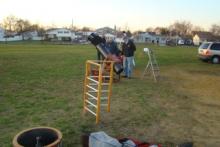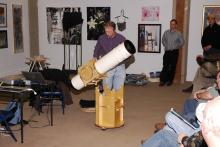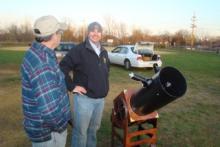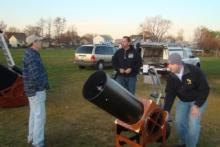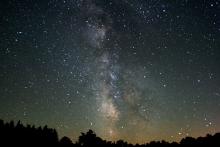Science Daily

Astronomy news. New! Earth-like extrasolar planet found; double helix nebula; supermassive black holes, astronomy articles, astronomy pictures. Updated daily.
Updated: 1 hour 54 min ago
NASA's Webb discovers dusty 'cat's tail' in Beta Pictoris System
Beta Pictoris, a young planetary system located just 63 light-years away, continues to intrigue scientists even after decades of in-depth study. It possesses the first dust disk imaged around another star -- a disk of debris produced by collisions between asteroids, comets, and planetesimals. Observations from NASA's Hubble Space Telescope revealed a second debris disk in this system, inclined with respect to the outer disk, which was seen first. Now, a team of astronomers using NASA's James Webb Space Telescope to image the Beta Pictoris system (Beta Pic) has discovered a new, previously unseen structure.
NASA's Webb finds signs of possible aurorae on isolated brown dwarf
Astronomers have found a brown dwarf (an object more massive than Jupiter but smaller than a star) with infrared emission from methane, likely due to energy in its upper atmosphere. This is an unexpected discovery because the brown dwarf, W1935, is cold and lacks a host star; therefore, there is no obvious source for the upper atmosphere energy. The team speculates that the methane emission may be due to processes generating aurorae.
Unlocking the secrets of a 'Hot Saturn' and its spotted star
A team of astronomers has unraveled the enigmatic atmosphere of the exoplanet HAT-P-18 b, shedding light on its intriguing blend of gases, clouds, and even the effects of its star's activity.
'Blob-like' home of farthest-known fast radio burst is collection of seven galaxies
In summer 2022, astronomers detected the most powerful and most distant fast radio burst (FRB) ever observed. Now, astronomers have pinpointed the extraordinary object's birthplace -- and it's rather curious, indeed. Using images from NASA's Hubble Space Telescope, the researchers traced the FRB back to not one galaxy but a group of at least seven galaxies.
Meteorite analysis shows Earth's building blocks contained water
Analysis of iron meteorites from the earliest years of the solar system indicate that the planetary 'seeds' that ultimately formed Earth contained water.
Final supernova results from Dark Energy Survey offer unique insights into the expansion of the universe
In the culmination of a decade's worth of effort, scientists analyzed an unprecedented sample of more than 1,500 supernovae classified using machine learning. They placed the strongest constraints on the expansion of the universe ever obtained with the DES supernova survey. While consistent with the current standard cosmological model, the results do not rule out a more complex theory that the density of dark energy in the universe could have varied over time.
Three iron rings in a planet-forming disk
Astronomers have detected a three-ringed structure in the nursery of planets in the inner planet-forming disk of a young star. This configuration suggests two Jupiter-mass planets are forming in the gaps between the rings. The detailed analysis is consistent with abundant solid iron grains complementing the dust composition. As a result, the disk likely harbors metals and minerals akin to those in the Solar System's terrestrial planets. It offers a glimpse into conditions resembling the early Solar System over four billion years ago during the formation of rocky planets such as Mercury, Venus, and Earth.
Space oddity: Uncovering the origin of the universe's rare radio circles
Astronomers believe they may have found the origin of the universe's giant odd radio circles: they are shells formed by outflowing galactic winds, possibly from massive exploding stars known as supernovae.
New images reveal what Neptune and Uranus really look like
Neptune is fondly known for being a rich blue and Uranus green -- but a new study has revealed that the two ice giants are actually far closer in color than typically thought. The correct shades of the planets have now been confirmed.
Is oxygen the cosmic key to alien technology?
Astrophysicists outline the links between atmospheric oxygen and the potential rise of advanced technology on distant planets.
Designing the 'perfect' meal to feed long-term space travelers
Imagine blasting off on a multiyear voyage to Mars, fueled by a diet of bland, prepackaged meals. As space agencies plan for longer missions, they're grappling with the challenge of how to best feed people. Now, researchers have designed the optimal 'space meal': a tasty vegetarian salad. They chose fresh ingredients that meet male astronauts' specialized nutritional needs and can be grown in space.

